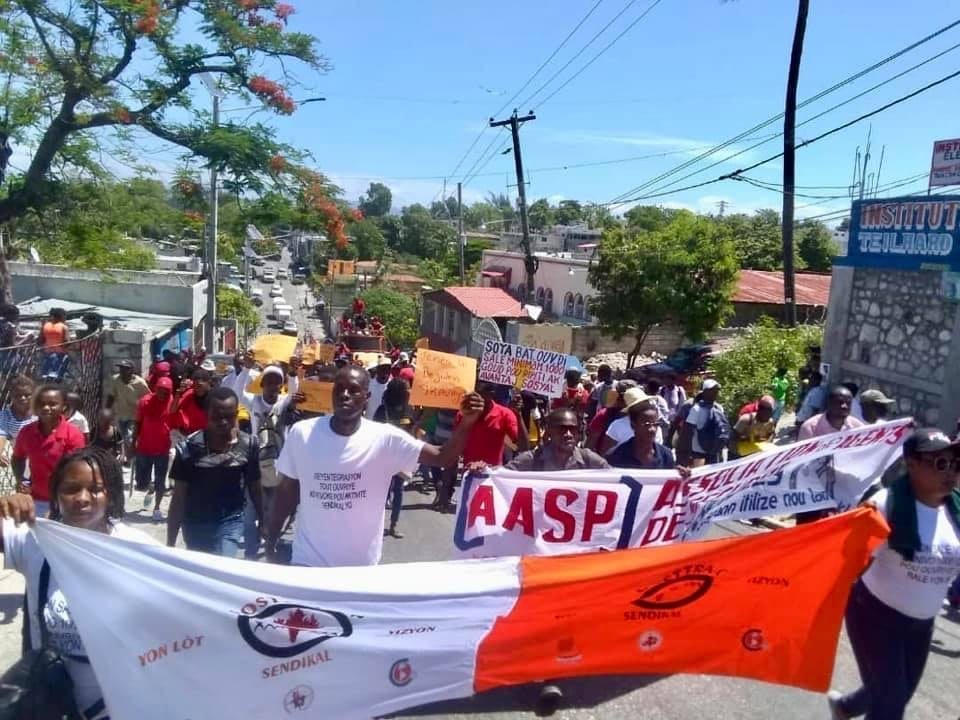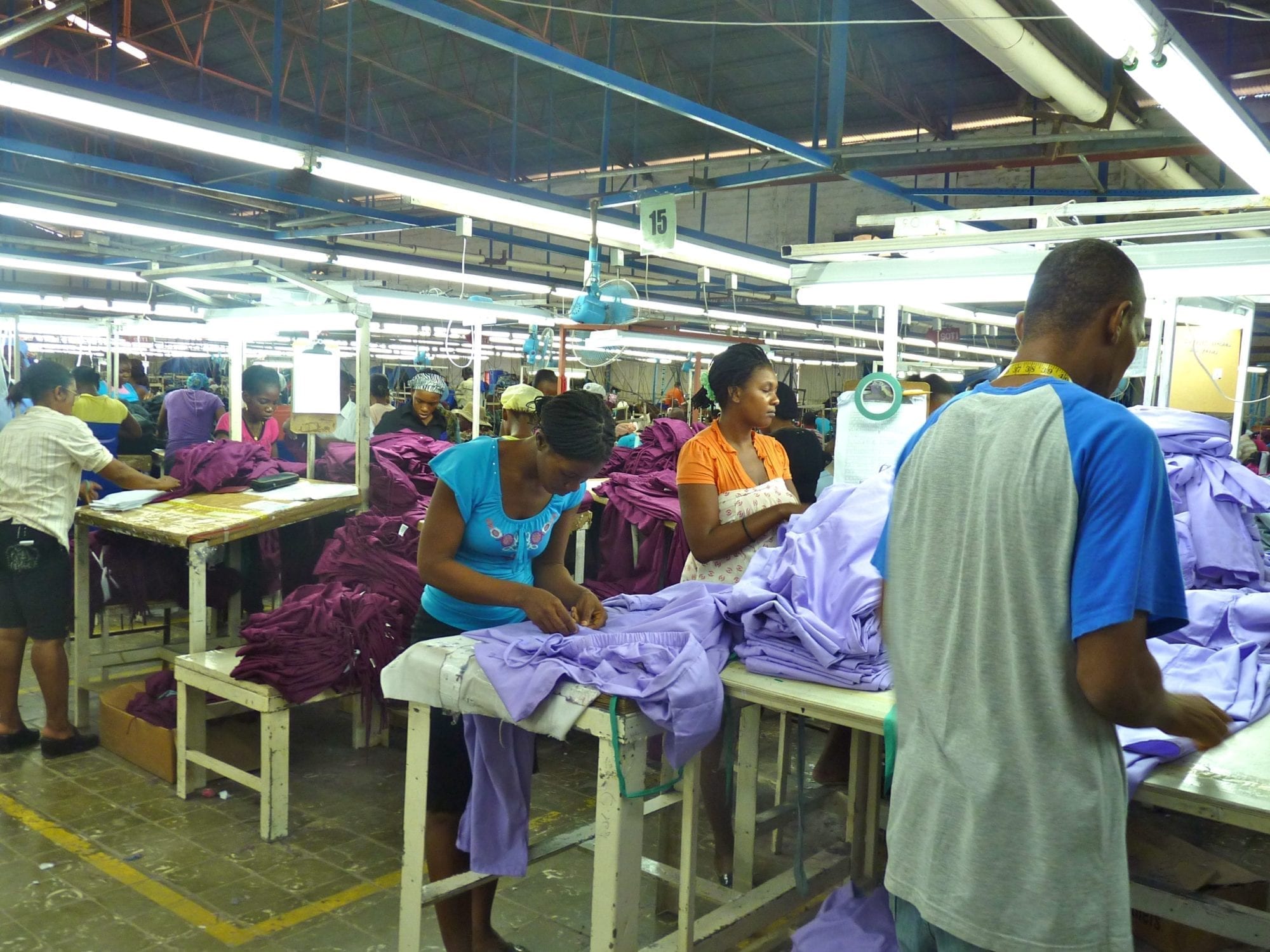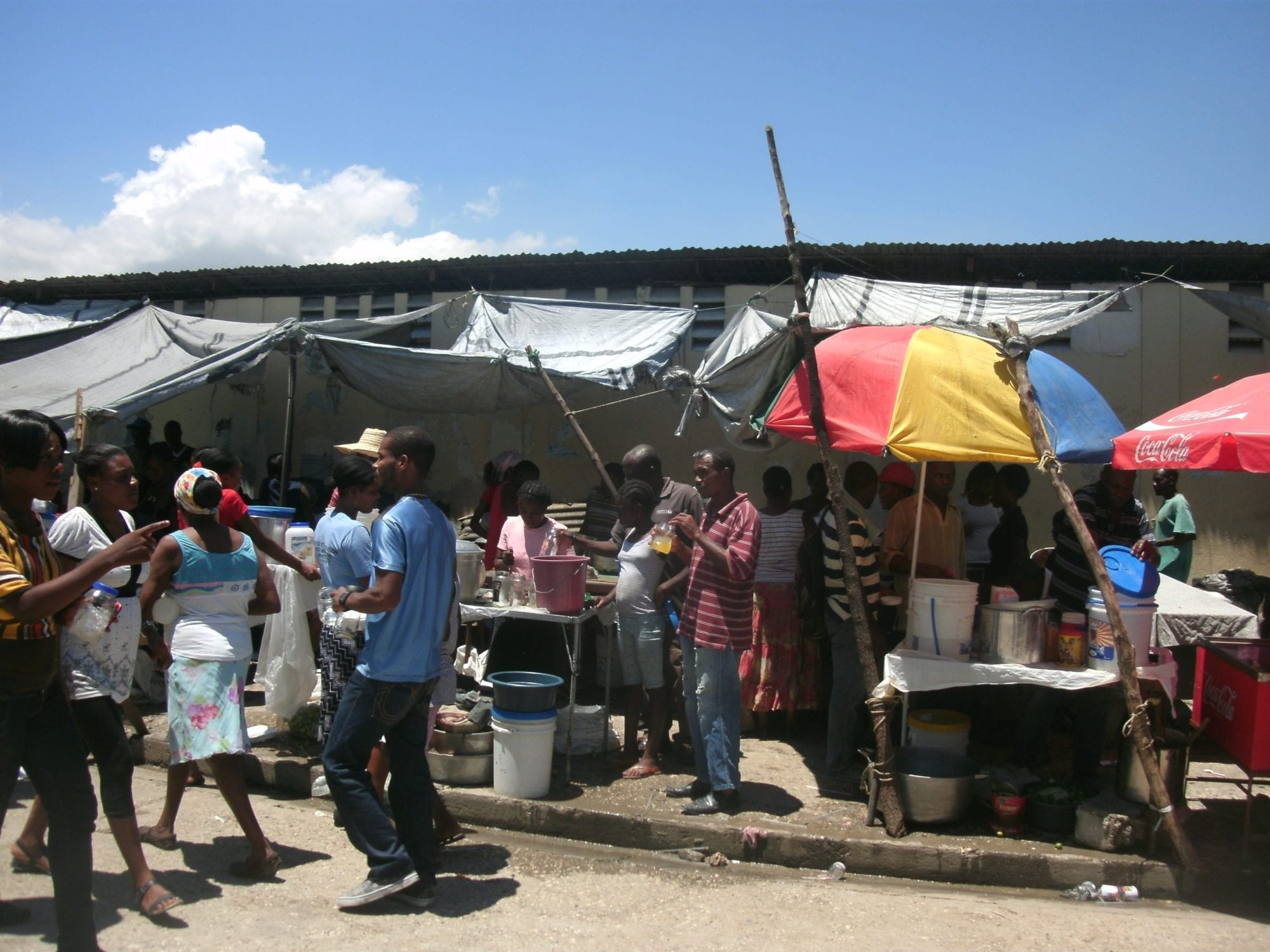
Jan 9, 2020
Ten years after a magnitude 7 earthquake destroyed a large swath of Haiti, killing more than 300,000 people and injuring another 1.5 million, workers and their families have not benefited from the billions in international aid that poured into country after the disaster. Nor has the government’s response—expanding low-wage, garment-sector jobs—alleviated poverty. Instead, they struggle to support their families with wages too low to live on even as escalating prices for fuel and other necessities compound the difficulties in their daily effort to survive.
“Workers live day by day,” says Reginald Lafontant, secretary general of the Groupement Syndicat des Travailleurs Textil pour la Reimportacion d’assemblage (GOSTTRA), a garment worker union and Solidarity Center partner.
In response to ongoing mass protests last fall against fuel and food shortages and government corruption, President Jovenel Moïse increased the minimum wage for garment workers and others in the export manufacturing sector from 420 gourdes a day to 500 gourdes ($5.09) a day. The miniscule increase left workers’ wages at less than 2018 levels because of inflation, and the move infuriated workers, who told Solidarity Center staff that the new wage is not enough to pay for food, transportation, housing, children’s school fees and medical care.
Workers Need $18.30 a Day to Support Themselves
More than 60 percent of Haitians survive on less $2 a day, and more than 2.5 million people fall below the extreme poverty line of $1.23 per day. The Solidarity Center report, “The High Cost of Low Wages in Haiti,” which tracked living expenses for garment workers from September 2018 through March 2019, recommends the government increase the minimum wage to an estimated $18.30 per day and allow workers to select their own representatives to the country’s tripartite minimum wage committee.
The cost of living in Haiti has increased by 74 percent since the Solidarity Center’s first wage assessment in 2014. Based on the current minimum wage, workers must spend more than half (55 percent) of their take-home pay on work-related transportation and a modest lunch, leaving little else to cover other necessities. Some workers say they can only afford to eat once per day.
The country’s inability to provide basic goods and services affects workers’ job security as well. With no propane available for cooking in the city, businesses last fall put their staff on unpaid leave. Hotels are closing and major airlines have cancelled flights to the country because of the economic and political turmoil, increasing unemployment and choking off income from much-needed tourist dollars. Haitians are outraged that the island has received millions of dollars in aid since the 2010 earthquake, but public services and infrastructure are nearly nonfunctional.
Haiti’s economy, which never recovered after the earthquake and the subsequent cholera outbreak that claimed some 10,000 lives, has worsened over the past three years. The Haiti Advocacy Working Group, which includes the Solidarity Center, is calling for policies that focus on an equitable and livable future and “promote the creation of decent employment that enables Haitian workers to adequately care for themselves and their families.”
Unions are in the forefront of calling for action to address the crisis. More than 40 labor organizations joined a call last fall for vast nationwide legal reforms, including free and fair elections and the resignation of Moïse. More recently, three Solidarity Center partner unions in the garment industry—GOSTTRA, Batay Ouvriye and Centrale Nationale des Ouvriers Haitiens (CNOHA)—rallied to call for better working conditions, the proper management of pension and social security funds, a living wage and government accountability for corruption.
The government failed to hold elections in October, and one-third of the Senate, the entire Chamber of Deputies and all local offices are set to expire in January 2020, setting the stage for a potential constitutional crisis and another round of widespread protests.

Jan 11, 2016
Six years after a major earthquake devastated the Haitian capital and its environs and the international community promised to “build back better,” Haitian workers say their daily lives are a struggle for survival, with their meager wages insufficient to cover basic expenses.
In recent interviews, Haitian garment workers told the Solidarity Center that they are worse off today than before the quake. With prices rising and wages largely stagnant, their paychecks do not allow them to support themselves and their families.
“We spend almost our entire daily wage on food and transportation,” said one garment worker interviewed. “We cannot save any money and we do not have enough money to get health care or education. Our future is compromised.”
Another worker said he sometimes has to borrow money to “make sure that at least the family has something to eat.”
Haiti is the poorest country in the Western Hemisphere and one of the poorest in the world. According to the World Bank, more than 6 million of Haiti’s 10.4 million people (59 percent) live under the poverty line.
Haitian garment workers hold rare full-time jobs in an economy that is largely informal, and work for profitable multinational manufacturers, some incentivized to come to Haiti and create jobs after the quake. Yet garment-sector wages are legally set below the national minimum wage and well below what is necessary to cover basic costs. A December 2015 Solidarity Center analysis of living expenses found that the average garment worker spends 160–225 Haitian gourdes ($2.80 – $3.94) a day on food and transportation for herself, and another 395 gourdes ($6.91) on food for the household. The current minimum daily wage for garment workers, who work 48 hours a week, is 225–240 gourdes ($3.94–$4.20). The minimum wage is supposed to increase this spring, to $5.11 for an eight-hour shift.
In 2013, Haitian workers and their unions waged rallies and protests to demand that the daily minimum wage be increased to 500 gourdes ($8.75) for export apparel workers. The government set the wage at less than half of that. In 2014, the Solidarity Center found that a living wage of 1,000 gourdes per day would allow workers to meet their basic needs.
“As we mark this grim anniversary, we have to ask why the people best-positioned to revive the Haitian economy—hardworking Haitians—are handicapped by abysmal and degrading wages. Until Haitians can earn a living that allows them to do more than barely survive, there will be no real recovery,” said Shawna Bader-Blau, executive director of the Solidarity Center. “The international community and Haitian government should be ashamed of policies that guarantee poverty wages and grant concessions to multinational corporations instead of providing real opportunities for Haitians workers to improve their lives and livelihoods and build a better country for themselves and their children.”

Apr 27, 2015
With thousands of people dead and even more made homeless in Nepal following a devastating magnitude-7.8 earthquake, Solidarity Center union allies in the country are reporting no casualties among their staff and are organizing to support relief efforts in the Nepali capital.
The General Federation of Nepalese Trade Unions (GEFONT), which represents mostly blue-collar workers, the Nepal Trade Union Congress (NTUC), which includes teachers and other white-collar workers and the Joint Trade Union Coordination Center (JTUCC), the umbrella organization of GEFONT and the NTUC, say their employees are safe and now working to provide disaster relief. Both GEFONT and the NTUC represent many workers in the tourist industry.
“Kathmandu valley is unimaginably destroyed,” says Bishnu Rimal, GEFONT president. “It is the most terrible quake we have ever experienced. Chilling cold, plus rain, lack of tents and [continuous] jolts is sufficient to scare people. It has disturbed even rescue work.”
The earthquake hit central Nepal on Saturday, from Mount Everest to Kathmandu and further west, wiping out entire villages. As rescue teams began to arrive from around the world, much of the stricken area remained inaccessible, locked in mountainous terrain with some roads blocked by landslides.
In letters to Rimal and Khila Dahal, NTUC general secretary, AFL-CIO President Richard Trumka expressed heartfelt condolences and solidarity.
“We will … work with the global labor movement to ensure that the working families impacted by this tragedy receive the support needed to rebuild their communities,” Trumka said.
The earthquake and aftershocks were felt as far away as Dhaka, Bangladesh, where one garment worker was killed and more than 200 injured as workers rushed out of factories when the quake hit.
At least one worker reported to Solidarity Center staff there that he took successful safety measures at his factory when the quake hit because of skills he learned at a recent Solidarity Center’s fire and building safety training. In recent months, the Solidarity Center has held a series of safety trainings for garment workers near Dhaka and Chittagong, where most factories are located. The 10-day trainings provide workers with hands-on fire and building safety experience, which includes steps to take during earthquakes.

Jan 9, 2015
Five years after the catastrophic earthquake in Haiti, workers are still struggling to pay for transportation, food and housing, as the cost of living rises exponentially while wages fail to keep pace.
In recent discussions with export apparel workers in Port-au-Prince, Haiti’s capital, the Solidarity Center found that workers may pay nearly half their daily wage on two daily meals. Sending a child to school can absorb most of their monthly pay.
Elmerome, who makes T-shirts and is paid 225 Haitian gourdes ($4.81) per eight-hour day, says even though his wages have risen from 125 gourdes per day before the earthquake, food for himself and his child every day costs 500 gourdes, or more than twice his daily income. In 2013, he spent about 400 gourdes a day on food. Meanwhile, his child’s education costs run about 5,000 gourdes a month.
Like all workers whom the Solidarity Center interviewed, Elmerome is a member of a union, a factor he attributes to improving his working conditions. He says the Centrale National des Ouvriers Haïtiens (CNOHA) union has “helped fight against discrimination, suspensions and dismissals, and “gives workers a voice.” He sees freedom of association as the most important element for Haitian workers seeking to improve their working conditions. And echoing other factory workers interviewed, he says many workers fear joining a union because of employer harassment, including the threat of being fired.
The Solidarity Center held these recent informal discussions as a follow-up to a study it conducted in 2014 to reassess the cost of living for export apparel workers in Port-au-Prince. “The High Cost of Low Wages in Haiti” concluded that, based on a standard 48-hour work week, Haitian workers should be paid at least 1,006 gourdes per day to adequately provide for themselves and their families. But like Elmerome, workers are generally paid between 225 gourdes (the minimum wage for export factories) and 300 gourdes a day or more if they are piece-rate workers. Further, the report says,
“Despite growth at the industry level, export apparel workers remain impoverished …. Companies that source from Haiti benefit from inexpensive labor costs, as well as lax enforcement of labor laws in an industry that is rife with worker rights abuses.”
Another factory worker, Widnise, told the Solidarity Center that she makes 225 gourdes a day and spends nearly half of that—110 gourdes each day—on food and transportation. Even with two people working in her household, she says, it is difficult to survive. Her rent is 20,000 gourdes a year.
In 2013, Haitian workers and their unions waged rallies and protests to demand that the daily minimum wage be increased to 500 gourdes for export apparel workers, but the government raised it to only 225 gourdes, effective last June.
Since then, Haitian unions have sought to secure improvements for workers through labor-employer discussions with the government on reforming the current labor code, boosting social protections and reviewing wage levels. The current labor code has not been updated in more than 28 years, and union leaders say stronger labor laws and improved social protections could go a long way to address many of the problems facing Haitian workers and their families.
In the apparel sector, Haitian unions are actively participating with employers in the Social Dialogue Table launched in early 2014. Haitian government representatives from the Ministry of Social Affairs and Labor Ministry participate as observers, along with other national and international organizations, including the Solidarity Center, the CTMO-HOPE Commission and the nonprofit, Better Work-Haiti. Union leaders say this process can potentially pave the way for improved workplace conditions, especially respect for worker rights.
“Our discussions with Haitian workers underscore a critical truth about the recovery effort: Subsistence wages have not helped workers surmount this disaster, much less allowed them to prepare for the next environmental or economic shock,” said Shawna Bader-Blau, Solidarity Center executive director. “For hardworking Haitians to live with dignity—and for Haiti to develop an economy that works for its people—fair wages are essential.”
The January 12, 2010, earthquake killed more than 200,000 Haitians and left another 1.5 million homeless. The disaster was followed by a string of tropical storms and a cholera epidemic that killed at least 8,000 people. Within days of the earthquake, the Solidarity Center dispatched regular truckloads of lifesaving emergency aid to Haiti from its field office in the neighboring Dominican Republic and carried out numerous aid and relief projects, together with allies like the American Federation of Teachers and TransAfrica. The report, “Workers Helping Workers Recover and Rebuild,” details the full range of the Solidarity Center’s multiyear relief and rebuilding effort in Haiti.
Jan 7, 2014

Credit: Congress of Haitain Workers
Four years ago this weekend, a massive earthquake brought catastrophe to the lives and livelihoods of tens of thousands of Haitians. Despite an outpouring of promises and millions of dollars in investment designated to help workers get back on their feet, the majority of Haitians still live in poverty. Instead of supporting recovery, their meager incomes fund little more than continued privation.
Formal jobs, particularly those in the export sector, were presented as the panacea to Haiti’s economic woes and key to helping Haitian men and women move forward. Yet four years after the January 12 quake, the country has five minimum wages, divided by sector—none of them enough to cover basic expenses, said Molly McCoy, Americas regional program director for the Solidarity Center. “These should be good jobs, but workers are telling us that no one is getting by.”
The Collective of Textile Factory Unions Organization (KOSIT), an alliance of four Solidarity Center partner unions in the garment sector, is calling for a minimum wage that will enable workers to meet their basic needs.
Workers with export-related jobs such as garment assembly, a sector that largely employs women, say they often take home lower than the minimum wage because it is tied to complicated and unreachable quotas. And recent studies point to factories cheating workers out of earned wages, exacerbating the struggle to earn a decent living. Meanwhile, prices in the island nation, a net importer of food and fuel, continue to rise.
As the Solidarity Center reported in 2011 and continues to hear from workers in the capital, Port-au-Prince, workers cannot earn enough to feed and shelter their family, cover transportation to work and send their children to school.
“Haiti needs a single minimum wage that all workers are able to earn—one that people can actually live on,” said McCoy. “Exploitive jobs that mire working people in subsistence lives is the wrong combination for recovery, much less for building Haiti back better.”





